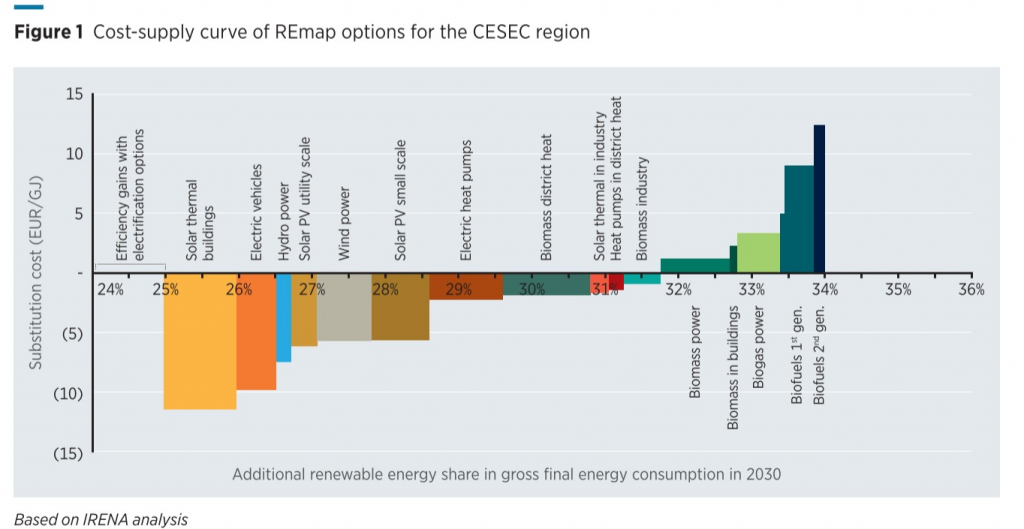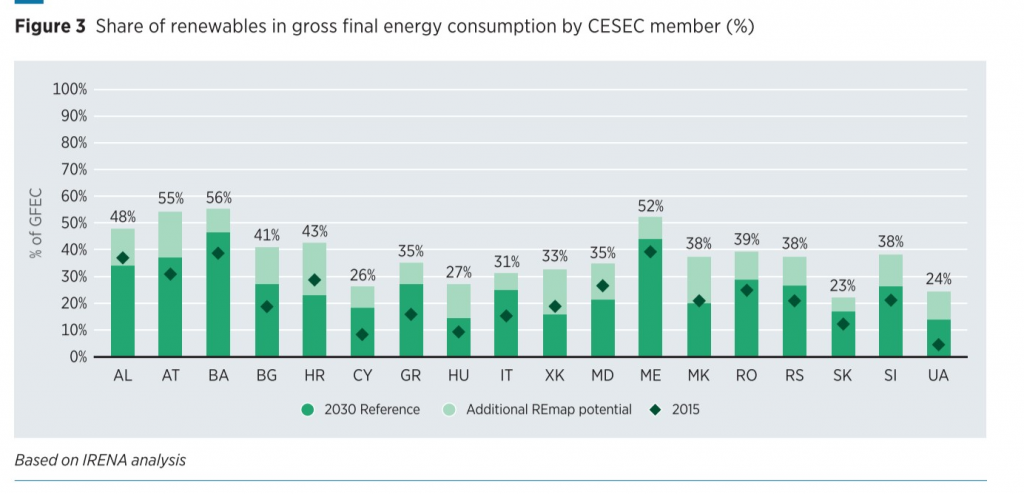“No model is an oracle that will tell you what the world will be in 2030. It will help you understand the problems or different pathways or challenges and indeed opportunities in actually reaching that future that you’re looking at.” Sean Collins, IRENA, Associate Programme Officer
How do we get to a low fossil-fuel system by 2030? This is the question the European Commission put to IRENA. In late 2020, the agency published the study on the “Renewable Energy Prospects for Central and South-Eastern Europe Energy Connectivity.” The CESEC report for a shorter title. The study was sponsored by the European Commission, and breaks down how the region can GO GREEN. The report breaks the myth about the cost and viability of building a sustainable energy system: Renewable energy can displace coal and gas in the next ten years – at a lower cost than old or new fossil fuel.
The opening quote is by Sean Collins who works on the IRENA team doing the CESEC modeling work. Sean, and a leader of the team, Luis Janeiro, a Programme Officer, joined me for a podcast interview on the results of their study. You can listen to the full-episode here. There is a great diversity in the countries in both size and wealth. But the overall conclusions were clear a more ambitious green path can be developed for the region.
The CESEC initiative spans nine EU member states: Austria, Bulgaria, Croatia, Greece, Hungary, Italy, Romania, Slovakia and Slovenia) and eight Contracting Parties of the Energy Community (Albania, Bosnia and Herzegovina, Kosovo* , Montenegro, North Macedonia, the Republic of Moldova, Serbia and Ukraine.
The purpose of the project was to outline how the region could increase the mix of renewables and get away from ‘business as usual’. The results demonstrate a clear trajectory for renewables in the region to replace fossil fuels. Through a clear plan on electrification of both heating and transport, utilizing wind, solar, hydro and biofuels a region wide shift can occur.
On the modeling side, Eurostat data is used which provides a good benchmark for all the countries and even comparison with other European countries. In the podcast we delve into the power sector and the diversity of the region of coal and hydro. The region is now facing a period of necessary new investments into generation. And here is where the cost of renewables versus fossil fuels becomes very important. Emerging from the data is the competitiveness of renewables which are the cheapest form of generation. Renewables, as Luis Janeiro points out, are even cheaper than the running costs of a coal power plant. The knock-on effect can be cleaner air and a cheaper system for consumers.
Underscoring this cost reduction and long-term savings are the projected savings by investing in renewables. Figure 1 (below) demonstrates this savings. As Louis points out in podcast,
“What we see in the markets now is that renewables are the cheapest form of generation in most conditions. And they are sometimes even cheaper than just the marginal running cost of existing fossil plants. So it’s sometimes cheaper to deploy a new solar plant than to pay for the fuel and the maintenance and the reinvestment in, in pollution control systems for a coalmine.”
Getting to 2030 on a clean energy trajectory is cost-effective and not pie-in-the-sky.

The benefits are seen on an individual country level in Figure 3 (below) from the study. I like this graph as it highlights the difference between what countries are planning to do (2030 reference) and what they can actually do if they invest in renewables in a more ambitious manner (2030 Remap).

Underpinning these models is the awareness of the need to integrate the national markets much more. The Agency for Cooperation of Energy Regulators (ACER) along with the European Commission is pushing for this greater market integration (see Single Energy Market). There is a necessity to integrate national markets and not have countries go it alone. As Sean states,
“If any country tries to go and alone and integrate these sources, they have to deal with all that variability, all in terms of their national generation, on their own, and it’s much more difficult to do it. Because over a wider region, this variability is averaged out. So you’re dealing with a much lower level of variability at a regional level. And that allows you to share different flexibility resources, and much less wasted energy or curtailment at sharing of renewables that have plummeted in cost, and just going in alone, or in a less cooperative way, is actually more technically challenging, and then it’s all it’s also more expensive.”
Energy independence may be a high goal for national politicians, but the benefits for cooperation and for the environment emerge through greater integration and cooperation – not self-reliance in energy resources. Although this self-sufficiency is also a misnomer, because whether a country has nuclear, coal or gas in these European countries both the technologies and resources are imported. So then it comes down to deciding whether energy dependence is done in the upstream (fossil fuel) environment or in the ‘downstream’ deployed grid network. Using renewable energy at a national or regional level improves security of supply while also improving the cost of energy for consumers.
The study provides an effective roadmap to increase renewables over the next nine to ten years. As Sean stated at the beginning that no model is an oracle, only the path needs to be chosen, this is the case here. The cost effectiveness of renewables are clear and the necessity to integrate and build a cooperative regional energy system delivers a more stable and secure energy system. IRENA maps out how a renewable energy trajectory can significantly reduce fossil fuel use and do so in a cost effective manner. Now it is up to the citizens and politicians of these countries to push forward on both cooperation and implementation of this cleaner vision.
Dr. Michael LaBelle is an associate professor at Central European University in the Department of Environmental Sciences. He produces the My Energy 2050 podcast to change how we communicate and improve the energy transition.
